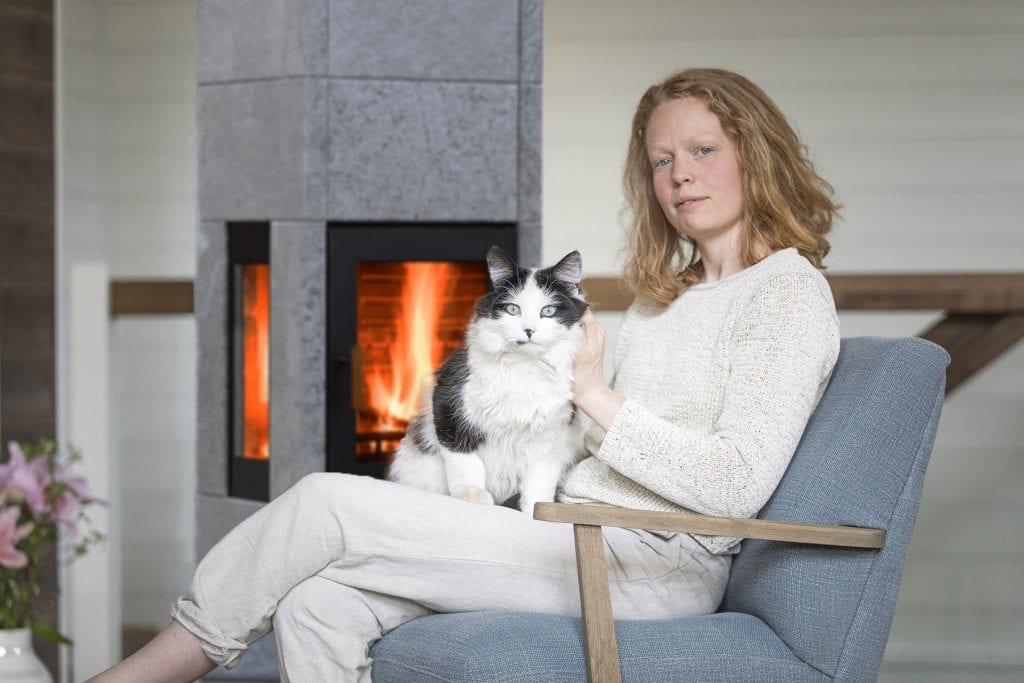About us
Hestia Industries was established in 2019 to import soapstone masonry stoves from Europe. The rich tradition of these type of stoves we wanted to bring to the Northern American market. So far we have already many very happy customers. We are proud to note that our customers are alike the Northern European customers when it comes to appreciating our soapstone wood stoves. Quite often we get feedback like ‘I can never think of any other type of woodstove anymore’. This is due to the unique characteristics of our products.
 Learn what makes our products truly unique
Learn what makes our products truly unique
There is an important concept one needs to understand and embrace when living in Scandinavia: being “koselig”.
Our wood burning stoves are individual and unique.
Each stone has a different structure and pattern, and no two stoves are the same.
Our soapstone is grey with a light structure. Our soapstone stoves are a warming piece of art that will last for generations. Soapstone is a metamorphic type of rock. This means that it was formed by other types of rock under pressure and high temperatures 500 million years ago. The soapstone is a soft rock, easy to mold and pleasant to touch. It can withstand heats up to 2800°F and is frost proof and resistant to chemicals. The soapstone from Norsk Kleber has a high talcum content. It is porous and heavy, and therefore has exceptionally good heat storage properties and is nature’s own ‘wonder material’, making for superb masonry heaters.
In Scandinavia, soapstone has been used in cookware and everyday objects ever since the formation of an Early Iron Age settlement in several regions in Finland, Norway, Sweden, as well as in Switzerland and the Alps and Dolomites of Italy. In the Stone Age, the special stone was used for clubs, picks and axes. During the Bronze Age, it was also used for spinning wheels, loom weights, fishing net weights and molds. Findings from soapstone fragments also suggest that the Vikings used soapstone for pots and other utensils. There is also evidence to suggest that the Vikings used soapstone to heat their homes, in woodstove-like structures. The extraction of soapstone directly from the rock face to make pots made an important contribution to many people’s livelihood. As with all types of stone, the quality of soapstone varies from place to place. Our soapstone has a relatively high magnetite content and is therefore particularly suitable for use in wood burning stoves and fireplaces. Heat absorption, storage and emission are optimal with our soapstone: the perfect material for a true masonry heater.
In the 13th century, soapstone was used as décor, and several castles, churches and cathedrals have soapstone adornments. One of the most well-known of these is the Nidaros Cathedral in Trondheim in Norway, which is decorated entirely with soapstone.
During the 19th century several producers in Scandinavia as well as in the Alps started to make closed stoves with cast iron doors for home heating. Those stoves typically had several layers of stones above the burn chamber for heating purposes, parallel to the development of the ‘Kachelofen’ in southern Germany. Most of this work was real handcraft: stones were carved by hand and fitted together at the spot in a home. A tidy work that could last for days or even weeks before a stove was built.
Today the production processes of such stoves have become very modern, with computer-controlled machines, while the products themselves are still based on the same principles as old soapstone stoves with the smoke from the burn being in direct contact with the stones, even though this makes our solutions somewhat more expensive than similar woodstoves. The reason for this is simple: we will not compromise on the quality of the products and their excellent heat storage properties.
The concept ‘koselig’
There is an important concept one needs to understand and embrace when living in Scandinavia: being “koselig”. Most English speakers translate it to “cozy” but that term does not truly cover everything that “koselig” can express.
Koselig is warmth and comfort. It’s being in the presence of loved ones in the evening. It’s laughing at home with your closest friends. It’s warming your feet by a soapstone woodstove while wearing knitted socks. It’s a feeling. It’s an action. It’s the atmosphere. Koselig is a lot of things. It’s cuddling with your significant other while sipping hot chocolate – or cuddling on the couch with chocolate ice cream, watching Netflix, whatever your thing is. It’s something as simple as the glow of a fire from a genuine masonry heater, efficiently burning wood.
